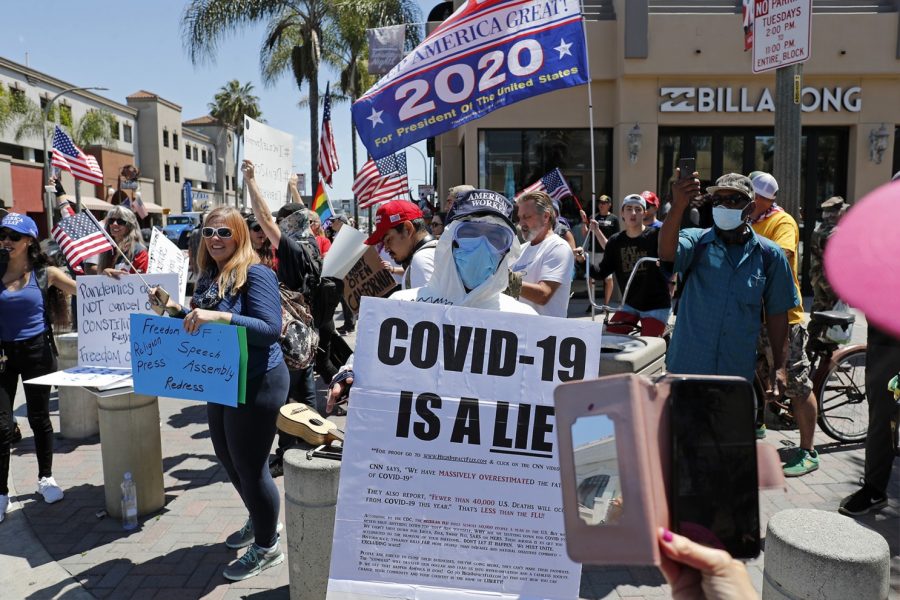More Than a Virus
Protests against the coronavirus in Huntington Beach reveal the priorities of some individuals during this critical, unprecedented time.
May 28, 2020
The COVID-19 pandemic erupting in December of last year has resulted in more than global lockdowns, economic recessions, and healthcare crises–it has completely flipped the world upside down in ways which expose the numerous flaws of the current status quo.
Socioeconomic disparities have always been prevalent, no matter the level of development of each country. With a global pandemic, however, these disparities have become glaringly obvious and emerged as a significant issue with serious consequences. Limited testing and healthcare resources have strengthened connections between wealth and health which have always existed but have become highlighted due to the coronavirus.
According to Time, COVID-19 is affecting lower-income communities and individuals much more prominently than those of higher-income due to lack of health insurance, financial freedom to be tested, and higher-quality jobs which provide health insurance and ensure healthy and safe working conditions. “COVID-19 will be felt most acutely by those least able to afford to combat it,” says Adam Harris of the Atlantic.
On the other hand, the wealthy can afford to receive not only testing freely, but also proper treatment and preventative measures. When NBA player Rudy Gobert tested positive for the virus, the NBA and the state of Oklahoma acted quickly, testing 58 players and personnel within a matter of hours. Their rapid response was not reflected across the country or even within the state, as the 58 tests consumed twenty percent of Oklahoma’s entire stock of test kits, according to the Atlantic.
As individuals from lower-income and ethnically disadvantaged backgrounds suffer from genuine symptoms of the coronavirus, the state invested its resources into a high-paying, high-status organization. Moreover, the wealthy fare far better in the new locked down, socially distant world as they enjoy their larger homes and plentiful sources of entertainment without concern for the financial consequences of temporarily losing their jobs.
While COVID-19 causes almost every individual to suffer equally health-wise, the financial aspects of the virus warrant that higher classes can afford to suffer less, exposing the flaws of the healthcare system and the pronounced repercussions of the socioeconomic hierarchy.
The pandemic has also revealed the various inadequacies of the government while allowing the world to scrutinize the clear strengths and weaknesses of different systems of governments as each country takes their own approach to combating the same issue.
In China, where cases of the coronavirus were first reported, the country acted gradually to control the spread of the disease. With the preliminary cases, concerns for the virus were allegedly low, and China took little measures to update the world as the country secretly suffered from high rates of infection and death, according to BBC. As the outbreak expanded both inside and beyond the country, China began to take more drastic measures, such as a strict stay-at-home order and drones which strongly discouraged citizens from leaving their homes.
China’s response to the coronavirus remains questionable, as several suspect the country hid the reality of its death rates and struggle, according to the New York Times. Many also denounce the World Health Organization (WHO) for its slow recognition of the virus, preventing many world leaders from taking action sooner, according to the Atlantic. In fact, WHO’s delayed reporting prompted President Trump to reconsider the U.S.’s relationship with the global organization; according to the Washington Post, Trump has threatened to permanently cut WHO funding if no significant changes are made within the organization.
As China’s economy sharply declined, other parts of Asia acted quickly to minimize the effects of the coronavirus. In Taiwan, for example, the government established a Central Epidemic Command Center which issued 124 safety protocols, according to NBC News. The protocols outlined guidelines for mask distribution and travel restrictions, and the country’s affordable healthcare system has also ensured Taiwanese citizens can painlessly receive testing and treatment.
In Europe, on the other hand, responses to the pandemic were mixed in terms of effectiveness. Countries such as Germany, Iceland, Finland, Norway, and Denmark adopted praiseworthy approaches to the coronavirus, according to Forbes. However, other countries such as Italy were forced to take unprecedented measures of complete lockdowns as their death and infection rates hit all time highs.
The United States falls on the less effective end of the spectrum, issuing health and safety guidelines which are more of strong recommendations than mandates. Most, if not all, states have closed “non-essential” businesses along with schools, universities, and recreational activities, forcing many to self-quarantine inside their homes. The Center for Disease Control and Prevention (CDC) constantly releases guidelines for proper hand-washing techniques, wearing face masks, and staying six feet from others to prevent the spread of the virus.
However, unlike many other countries, the U.S. has not required social distancing or wearing protective face masks in public. Although most stores and businesses require customers to wear face masks to enter and purchase, many citizens refuse to do so, claiming constitutional rights and freedom of expression over the safety of themselves, their families, and their community. In fact, the national closures and job losses have outraged some Americans to the point of protest throughout the country.
According to ABC News, over 1,000 individuals gathered in Huntington Beach in early May to protest the minimal policies enacted against the coronavirus, voicing their prioritization of haircuts over health and their indignation at the “facism” and “tyranny” of efforts to reduce deaths and strains on hospitals throughout the world.
The government has further largely ignored the desperate pleas from hospitals for more funding for essential resources such as testing kits and N95 masks. There is a complete lack of a consistent testing system, as seemingly only those who can afford to be tested will do so. The U.S. even lacks a uniform national policy regarding closures and health guidelines; each state varies in its response to the coronavirus. Rather than the rapid, efficient response the crisis demands, the president spent most of the critical two-month period following the initial outbreak in Wuhan denouncing the virus as a hoax.
The United States’ failure to recognize the significance of COVID-19 has resulted in its ineffective policies which have had equally ineffective impacts. According to the CDC, the U.S. passed 100,000 deaths from the virus in late May, giving the country the highest death rate in the world. The country’s lead in medicine and healthcare is not to blame, however–the government, divided and ineffective as ever during one of the most critical events of the country, is.
In another question of priority, the United States has initiated the slow re-opening of businesses across the country, ignoring the climbing infection and death rates in favor of alleviating the economy. Although the economic recession resulting from COVID-19 has adversely affected thousands, even more will fall sick if the U.S. prematurely returns to normalcy. To Andrew Nguyen (12), businesses reopening makes him “uneasy. The coronavirus hasn’t ended, but people are going to start acting like it has, and when they do, everything will only get worse.”
As limited and costly testing highlights the role of socioeconomic disparities in the flawed healthcare system, the variety of governments’ responses to an identical issue calls into question the methods of age-old political institutions. Citizens can evaluate the effectiveness or lack thereof of their governments. In the United States, in particular, the combination of both the government and its citizens’ lack of understanding and respect for the weight and reality of the situation at hand has resulted in a death toll higher than that of World War I.
COVID-19 has accomplished more than the health consequences and death from a typical virus–it has also initiated global lockdowns, closures, and economic recessions. More importantly, it has revealed the numerous prominent shortfalls of our modern institutions, allowing individuals to demand change and world leaders to recognize the need for change.
These inadequacies did not suddenly develop due to COVID-19, however. They have always lurked beneath the public eye, emerging only through the power of an unprecedented global pandemic.





































